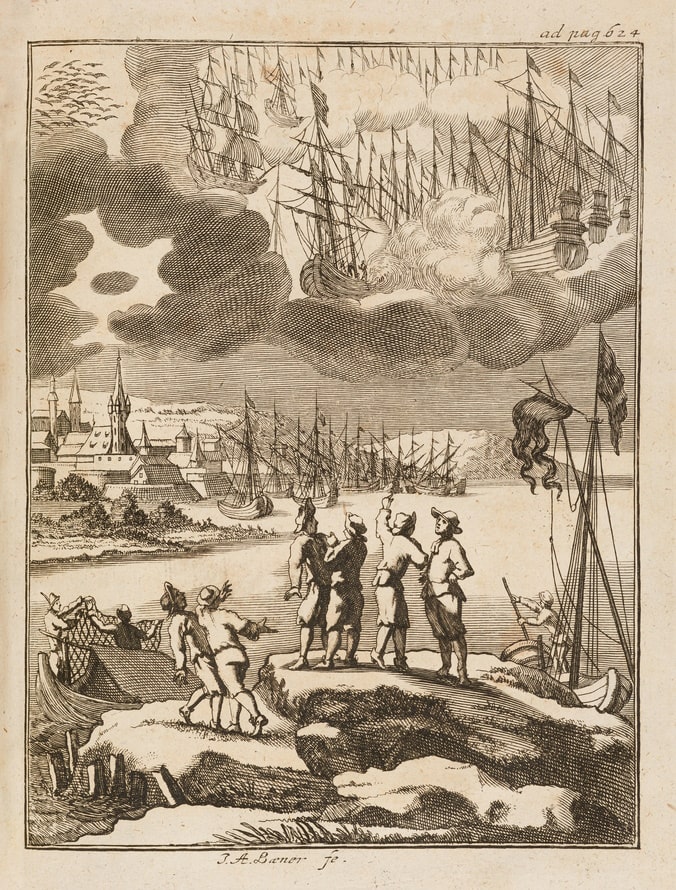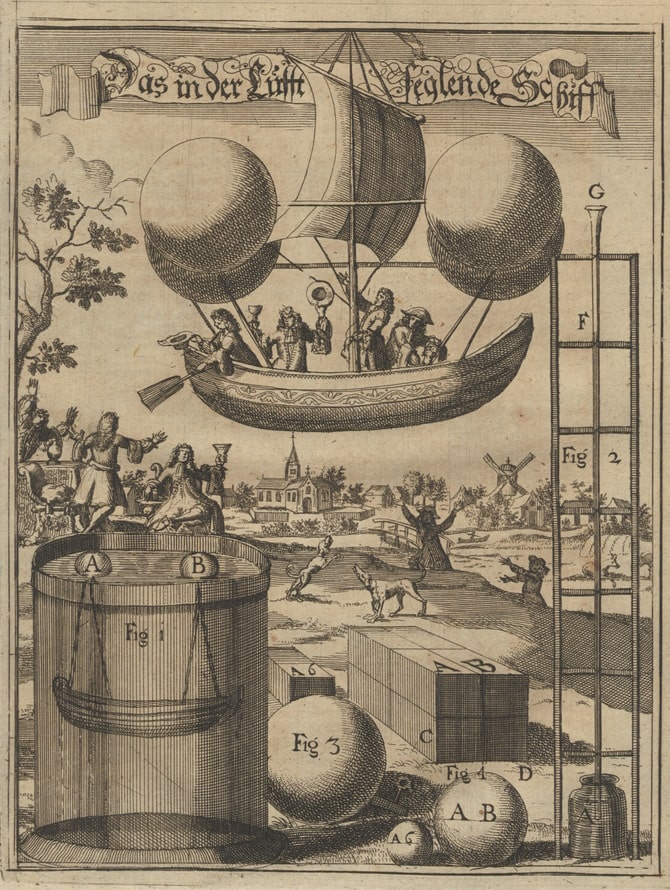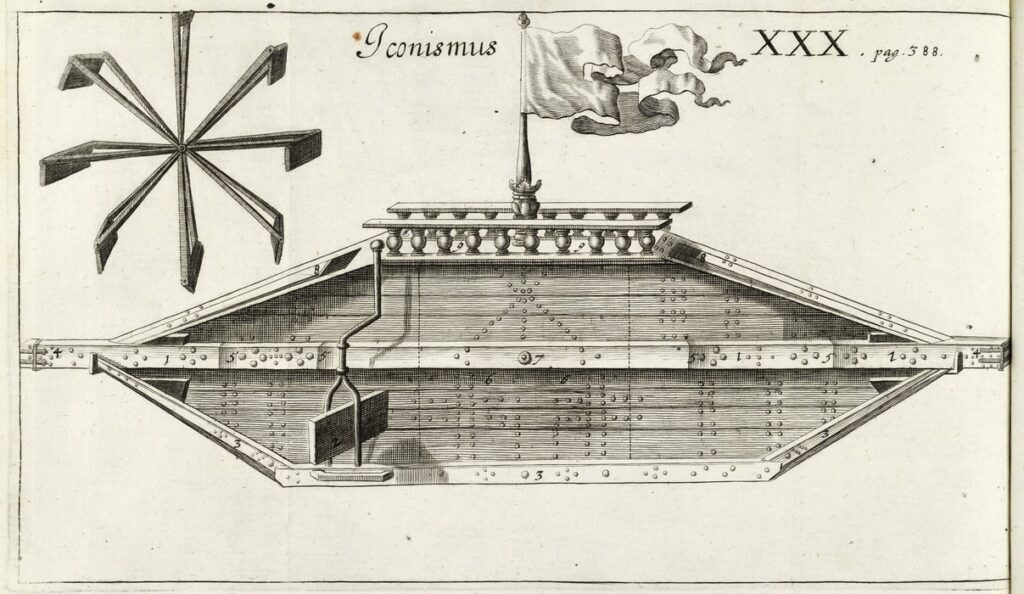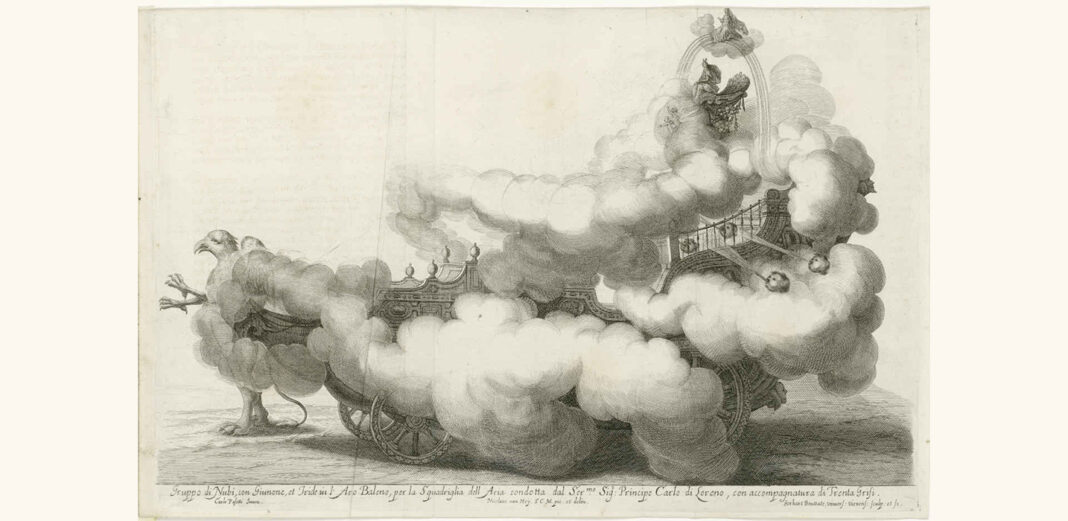In April 1665, six fishermen became eyewitnesses to an inexplicable celestial phenomenon – an aerial battle over the Baltic Sea near Stralsund, towards evening a dark grey disc appeared over the middle of the town. “UFO 1665” is the first exhibition on this historical UFO sighting. Using contemporary image and text sources, it reconstructs the media career of the event and reveals thought patterns and communication strategies that still determine reporting on “Unidentified Aerial Phenomena” (UAPs) today.
Fig. above: Depiction of a fantastic airship from the wedding feast of Emperor Leopold I, illustration from: Sieg-Streit deß Lufft und Wassers Freuden-Fest, Vienna, 1667, © Staatliche Museen zu Berlin, Kunstbibliothek
The exhibition is an expedition into a strange world of images that hides from the mass public of museums between the pages of old books or in archives. Those who only know 17th century art from the large painting galleries will rub their eyes in surprise. One has the impression of entering a baroque parallel universe with strange signs in the sky, airships, space rockets and flying discs.
Everything revolves around one of the most spectacular celestial phenomena of modern times: on 8 April 1665, 2 p.m., six fishermen fishing for herring off Stralsund observe how flocks of birds in the sky transform into warships engaged in thunderous aerial battles. Ghostly figures swarm on the decks. When, towards evening, “a flat round shape like a plate” appears above the church of St. Nicholas, they take flight. The next day, they shake all over and complain of pain.

Uberzug unserer Nider-Welt/ Oder Erd-umgebende Lufft-Kreys/ […], Nuremberg 1680,
Copper engraving, © Staatsbibliothek zu Berlin, Department of Manuscripts and Historical Prints
The news spread like wildfire in the media. Leaflets and newspapers competed with each other with the most diverse versions and interpretations. Above all, religious convictions determined the media transformation of the event. People could not have known that it was an atmospheric reflection of a sea battle raging behind the horizon. They lived in the belief that the universe was ruled by a god who could project impending visitations into the sky. The air battle was also interpreted as such a “prodigium” (Latin for “portent”).
Likewise, 17th century image design had a significant influence on the medial transformation of the air battle. Futuristic visions of airships, for which the people of the 17th century were enthusiastic, played a special role. More than 100 years before the first manned balloon flight, Francesco Lana Terzi (1631-1687) had published the design of a flying boat carried by vacuum spheres, which caused a furore throughout Europe. The fact that the project could never be realised did not dampen the euphoria. People dreamed of conquering air space.

Grösseste Denkwürdigkeiten der Welt Oder so genandte Relationes Curiosae, Hamburg 1689,
Copper engraving, © Staatsbibliothek zu Berlin, Department of Manuscripts and Historical Prints
Another theme of the exhibition is the power of myths: when, on 19 June 1670, lightning struck the Church of St. Nicholas, of all places, over which the disc had appeared ominously five years earlier, the celestial phenomenon was interpreted in retrospect as a sign of God’s wrath. Contemporary descriptions and depictions of the event conjured up a mysterious connection with the destruction of Babylon by a gigantic millstone, as described in the Revelation of John.
The collective image of the air battle over Stralsund is not only shaped by the media, beliefs, designs and myths of the baroque age. It also reveals what could not have been imagined at the time. For example, no 17th century source mentions extraterrestrials in connection with inexplicable celestial phenomena. Yet the human imagination had long since reached the point of imagining expeditions to inhabited planets and corresponding propulsion systems. Why, however, no one had the idea that extraterrestrials could appear in our skies with flying machines is one of the many mysteries that the exhibition attempts to solve.

Nuremberg/Würzburg, 1664, plate XXX, © Staatliche Museen zu Berlin, Kunstbibliothek
At the end of this cultural and media-historical investigation, there is an excursion into the present. The focus is on the videos and reports of sightings of mysterious “Unidentified Aerial Phenomena” (UAPs) by the US military that went viral in 2019 and even made it onto the cover of an issue of Der Spiegel two years later. The range of interpretations discussed is maddeningly wide. Are they physically explainable natural phenomena, superior high-tech drones of Chinese or Russian production, extraterrestrials or even visitors from the future? Even NASA and the Pentagon don’t seem to have a clue. One thing is certain, however: the factors that were decisive for the media career of “UFO 1665” have lost none of their power to this day.
WHERE?
Kunstbibliothek
Matthäikirchplatz 6
10785 Berlin-Tiergarten
WHEN?
Friday 5 May until Sunday 27 August 2023
Di – Fr 10:00 – 6:00 pm
Sa + So 11:00 – 6:00 pm






